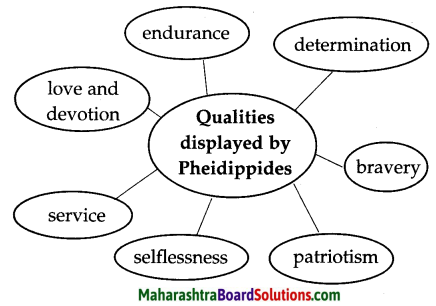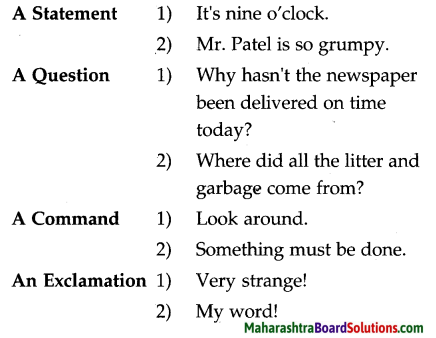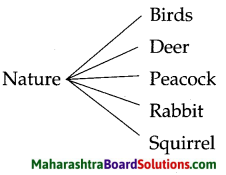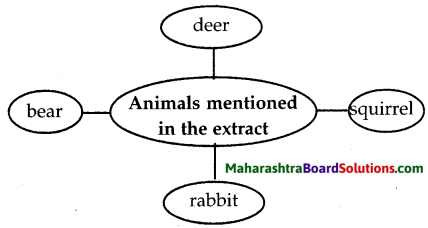Std 5 English Lesson No 27 The Legend of Marathon Question Answer Maharashtra Board
Balbharti Maharashtra State Board Class 5 English Solutions Chapter 27 The Legend of Marathon Notes, Textbook Exercise Important Questions and Answers.
5th Std English Poem The Legend of Marathon Question Answer
English Balbharati Std 5 Digest Chapter 27 The Legend of Marathon Textbook Questions and Answers
1. Show the major events in the story of Pheidippides on a ‘time-line’.
Question 1.
Show the major events in the story of Pheidippides on a ‘time-line’.
Answer:
- Persians get ready to attack Athens.
- Messenger Pheidippides sent to seek help from Sparta but Spartans unwilling.
- Battle between Persians and Athenians begin.
- Athenians emerge victorious.
- Before the news of victory reaches Athens, Persians plan to take over Athens.
- Athenian Generals plan to defend Athens by letting Athenians know of the victory.
- Pheidippides entrusted responsibility.
- Braving all odds, an exhausted Pheidippides completes the journey.
- Delivers the message but collapses due to exertion and loses his life.
- Marathon included in the Olympic Games – (the games which were stated in Greece) in honour of Pheidippides.
![]()
2. Activities :
1. Prepare and present a short speech on the following.
Question 1.
An inspiring incident in the life of a great leader.
Answer:
Do it yourself
Question 2.
How I accomplished a difficult task.
Answer:
Do it yourself
2. Write a short essay on the following.
Question 1.
My favourite sports event.
Answer:
My favourite sports event
My favourite sport is cricket, one of the most popular games in India. I am interested in one-day matches, test matches and twenty-twenty matches. The just-concluded World Cup showed how a team which shows consistency, determination and dedication can emerge a winner.
I am a member of the school cricket team. I love this game so much that I don’t miss even a single practice session. I have won several inter-school competitions along with other members of my team. – On two occasions, I have also won the ‘Man of the Match’ award. I excel in batting and I am very good. in fielding too.
Playing cricket has developed qualities of hard work, determination and team spirit in me. I would like to scale the heights achieved by my favourite cricketer Sachin Tendulkar and become a world-class player. I have a long way to go but I am sure I will excel in my favourite sport.
![]()
Question 2.
What I would like to do for my country.
Answer:
What I would like to do for my country
Everyone loves his motherland and likes to serve it. But very few people know how best they can do so. I have various choices before me. If I want more exciting work, I may join the Army, the Air Force of the Navy. By doing so I shall strengthen the defense of the country. I may thus get a chance to lay down my life for the sake of the country. No service can be greater than the sacrifice of my life for the protection of our freedom. A place among the immortals is assured into those who die for the defense of the country.
Less glorious,l but not less important is the service to the country done by a teacher or control or a farmer or a worker. Every man in his station of life can serve his country doing his duty to the best of his ability So whatever be my occupation in life. I c can serve my country by doing my duty well. However, I am only a student at present. How can I serve my country best as a student? I can serve my country in many ways. I am a student of science and therefore I should prepare myself to become a true scientist.
Our country needs a number of scientists. By preparing myself to become a scientist I can do a very useful service to the country. Secondly, being the son of a shopkeeper I can explain to my father the need to hold the price line. If I can bring him round it will be not nor mean service to the country. Thirdly, I own a house which has a garden around it. I can grow more vegetables in my kitchen garden thus add my mite towards the solution of the food problem. Along with this at the end of the months at the end of the month and thus can serve the country by saving some food.
![]()
English Balbharati Std 5 Answers Chapter 27 The Legend of Marathon Additional Important Questions and Answers
Answer in one sentence:
Question 1.
Who were getting ready to attack the city – state of Athens?
Answer:
The army of Persia, which was a mighty kingdom, was planning to attack the city – state of Athens.
Question 2.
Why did the Athenians decide to send a special messenger to the neighbouring Kingdom of Sparta?
Answer:
The Athenian soldiers decided to send a special messenger as they needed help from other Greek Kingdoms to fight the Persians.
Question 3.
Who was sent as a special messenger to Athens?
Answer:
Pheidippides was sent as a special messenger to Athens.
![]()
Question 4.
Why did the people of Sparta refuse to join the battle?
Answer:
The people of Sparta were busy with some ceremonies and so they did not want to join the battle immediately.
Answer briefly.
Question 1.
Write in short about the battle between the Athenians and the Persians.
Answer:
The Athenians decided to launch a surprise attack on the Persians.The Athenian soldiers penetrated the Persian forces like speeding arrows. Taken aback, the Persians too showered arrows on the Athenian soldiers. But their arrows fell off the helmets and strong armours of the Athenian soldiers. The familiarity of the Athenians to their sea shore and the fact that Persians were on a new terrain too helped the AtheniAnswer: Lots of soldiers died, many were injured, while some got lost in the marshy area. The battle was over when the Athenians successfully drove back every single remaining Persian soldier back to the ships anchored in the sea.
Question 2.
What was the plan that the Persians formed to take over Athens?
Answer:
The entire army of Athens had rushed to the sea-shore with only the aged people, women and children left in the city. Taking advantage of this, the Persians decided to take the sea route. The Athenian army had no ships and they would take a very long time to travel back to Athens on foot with their heavy armour and weapons. Seeing the Persians, the defenceless people in the city would think that Athens had lost the battle and it would thus become easy for the Persians to take over the city.
![]()
Complete the web diagram :

Match the meanings:
Question 1.
| 1. penetrate | a. start |
| 2. launch | b. fall |
| 3. boost | c. pierce |
| 4. collapse | d. increase |
Answer:
| 1. penetrate | c. pierce |
| 2. launch | a. start |
| 3. boost | d. increase |
| 4. collapse | b. fall |
From words.
Question 1.
Give one word for :
- A high steep rock face especially seen at the edge of the sea
- The route of a journey from where we start to its end
- Keep in memory by a celebration or memorial
Answer:
- cliff
- course
- commemorate
![]()
Language Study :
Question 1.
Give the noun forms of:
- mighty
- compared
- brave
- strong
Answer:
- might
- comparison
- bravery
- strength
Question 2.
Adjective forms of:
- reach
- mountain
- hunger
- event
Answer:
- reachable
- mountainous
- hungry
- eventful
Question 1.
Complete the table:
Answer:
| Positive | comparative | Superlative |
| 1. young | younger | youngest |
| 2. heavy | heavier | heaviest |
| 3. fast | faster | fastest |
| 4. weak | weaker | weakest |
| 5. short | shorter | shortest |
![]()
Do as directed:
Question 1.
- Persia was a mighty kingdom. (Pick out the adjective)
- They were getting ready to attack the state of Athens. (Underline the compound word)
- They did not want to join the battle immediately. (State the part of speech of the Underlined word and state its kind)
- They had a strong cavalry and skilled archers. (Pick out the conjunction)
- The Persians were new to the terrain. (Forma wh-question to get the underlined words as the answer)
- Only the aged people, women and children were left in the city. (Pick out the Noun)
- Marathons are arranged in many countries. (Separate the subject and predicate)
- Joy to you! (State the kind of sentence)
Answer:
- mighty
- city-state
- immediately Adverb
- and
- Who were new to the terrain?
- Nouns: people, women, children, city
- Subject : Marathons, Predicate : are arranged in many countries.
- Exclamatory sentence
![]()
Reading Skills, Vocabulary and Grammar
Read the following passage and answer the questions below:
Question 1.
Who said this to whom:
We won! Our army will be here soon.
The above words were said by
Answer:
Pheidippides to Athenians
Question 2.
What does the extract tell us?
Answer:
The extract tells us of the efforts taken by Pheidippides to reach Athens to deliver the message of their victory thereby saving Athens from being taken over by the Persians.
![]()
Question 3.
What was the distance which Pheidippides had to cover?
Answer:
Pheidippides had to cover a distance of more than forty kilometres.
Question 4.
Pick out a line to prove that Pheidippides was determined to reach Athens.
Answer:
He just ran and ran.
Question 5.
What happened in the end?
Answer:
In the end, Pheidippides collapsed after delivering the message, never to rise again. He had laid down his life in the service of Athens.
Question 6.
Make sentences.
(a) Heart began to beat faster:
(b) To lay down one’s life
Answer:
(a) As the teacher started announcing the results my heart began to beat faster.
(b)We should be ready to lay down our life for our country
![]()
Question 7.
Are you inspired by Pheidippides? Justify your answer.
Answer:
Yes, I am inspired by the patriotism displayed by Pheidippides. He safeguarded the security of his country at the cost of his life. His determination to fulfill the responsibility assigned to him shows his love for his country.
The Legend of Marathon Summary in English
Summary :
The legend of Marathon is an inspiring story of a young man of twenty-two, Pheidippides. There was a battle between the Persians and the Athenians but the former refused to accept defeat. They saw that the entire army of Athens was far away from their city with only aged people, women and children back home at Athens. The Persians made a plan to take the sea route and reach and capture Athens before Athenians returned to the city to celebrate.
Luckily the Athenian Generals, being good strategists could foresee this situation. The message about their victory delivered before the Persians reached Athens. Pheidippides, the fastest runner who could travel faster than the Persian ships was entrusted the responsibility. A true patriot, he accepted it happily. That he had already completed a run of more than two hundred kilometres, just the day before, when he had been to the neighbouring kingdom of Sparta did not deter him from the task given to him.
He did his best; braving all odds and difficulties he tirelessly kept running. He was weak with hunger and thirst, his heart was beating faster but he continued the mission of reaching the city. He informed the people of Athens that they had won and that their army would be there soon. But Alas! After doing the duty assigned to him he collapsed. He had sacrificed his life in service to Athens, thus setting an example of selflessness and courage, patriotism and devotion to one’s motherland.
His willingness to do anything for his state and his historic run from Marathon to Athens is unforgettable. The sporting event of the Marathon which we witness in Olympic Games was started in Greece in the memory of this great young man Pheidippides.
![]()
Meanings :
- mighty (adj) – very strong and powerful.
- city-state (n) – an independent state consisting of a city and its dependent territories
- messenger (n) – the one who communicates a spoken or written message
- ceremonies (n) – an occasion which is grand and includes rituals.
- response (n) – answer.
- launch (v) – start.
- penetrated (u) – pierced.
- cavalry (n) – troops of soldiers with armour
- archers (n) – one who shoots with bow and arrow
- terrain (n) – land.
- anchored (v) – a ship held firmly in a particular place by a heavy device attached to the ship by a rope, chain or cable.
- devised (v) – planned.
- armour (n) – a protective covering made of metal used in battle fields.
- strategists (n) – experts who plan and direct the war operation.
- boost (u) – increase.
- morale (n) – confidence.
- delivered (v) – handed over.
- mission (n) – an important task.
- historic (adj) – relating to ancient past.
- commemorate (v) – keep in memory by a celebration or memorial.
- marathon (n) – a sporting event first introduced in Olympic games started in Greece.
English Balbharati Std 5 Answers Unit 4
- The Man in the Moon Class 5 Question Answer
- Water in the Well Class 5 Question Answer
- The Legend of Marathon Class 5 Question Answer
- All about Money Class 5 Question Answer
- A Lark Class 5 Question Answer
- Be a Netizen Class 5 Question Answer
- Give your Mind a Workout! Class 5 Question Answer
- Helen Keller Class 5 Question Answer
- Rangoli Class 5 Question Answer






